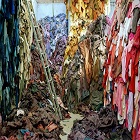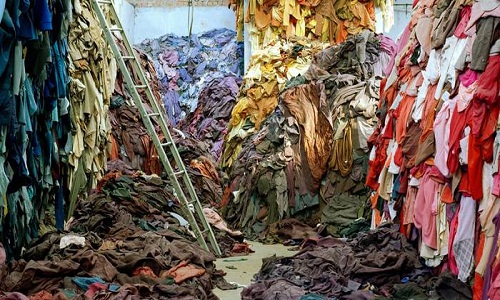Every piece of clothing being bought has had an impact on the planet before its even brought home. First of all, there’s water consumption. Two billion pairs of jeans are produced every year, and a typical pair takes 7,000 litres of water to produce. For a t-shirt, it takes 2,720 litres of water to make just one – that’s the average water consumption of a person over three years old!

Every piece of clothing being bought has had an impact on the planet before its even brought home. First of all, there’s water consumption. Two billion pairs of jeans are produced every year, and a typical pair takes 7,000 litres of water to produce. For a t-shirt, it takes 2,720 litres of water to make just one – that’s the average water consumption of a person over three years old!
Secondly, there’s the dying process of which 1.7 million tonnes of various chemicals are used; not to mention the hazardous chemicals like PFCs that leave a permanent impact on our environment. And what about the clothing that doesn’t make it to market? An estimated 400 billion square meters of textiles are produced annually, of which 60 billion square meters are left on the cutting room floor. Each year over 80 billion pieces of clothing are produced worldwide, and after its short lifespan, three out of four garments will end up in landfills or be incinerated. Only a quarter will be recycled.
Retail growth

A report by UK-based NGO WRAP said, lower prices and reduced demand lessen the incentive for collecting used textiles, which could lead to more going to landfill. And as recent Goldman Environmental prizewinner Zuzana Čaputová has shown, no one wants more landfills in their town. In an era of fashion bloggers and getting instant fame, being seen in the same outfit has been enough to warrant a ‘tsk-tsk’ from the fashion police. Just over the last five years, the top fast fashion retailers grew 9.7 per cent per year, topping the 6.8 per cent of growth of traditional apparel companies.
According to ‘Plenitude: The New Economics of True Wealth’ by Juliet B Schor, Americans for instance, consumes three times as much as their ancestors did 50 years ago, and they buy twice as many items of clothing as they did 20 years ago. In 1991, the average American bought 34 items of clothing each year. By 2007, they were buying 67 items every year. That’s a new piece of clothing every four to five days.
Environmental impact
If one stays away from impulse purchases, it can make a difference. It’s not just about saving pennies – in the lead up to the third anniversary of the collapse of the textile factory, Rana Plaza in Bangladesh, it’s as much thinking about who made your clothes as well as the environmental impact it has made. And if one thinks dumping a bag of clothing at the local thrift store is a sustainable idea, think again. H&M’s recent World Recycling Week, in which their aim was to collect and recycle 1,000 tons of used clothing, is an ‘illusion’ of what true sustainability is, as only one per cent of collected clothing can be used as recycled fibers.
Nearly 95 per cent of discarded clothing can be upcycled or recycled. And fashion trends come in waves, so to hang onto 10-year-old T-shirts is a good idea. One could actually be wearing it again in 20 years time.












